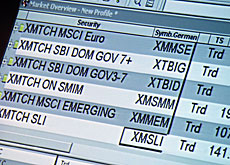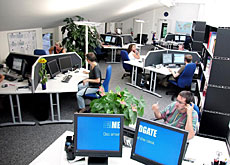New blue chip index targets pension funds

The Swiss stock exchange (SWX) hopes to attract new business from institutional investors in the United States by setting up a blue chip index of top performing firms.
The Swiss Leader Index (SLI), launched on Monday, comprises 20 large and ten mid-sized companies. Each firm has limited exposure within the index to comply with US and European Union rules.
It paves the way for trading between the SLI, the Eurex and various US stock markets.
“Because the capped index meets the provisions of Swiss, EU and US law, the products traded on it allow new markets to be tapped. This is turn generates liquidity for the basket companies [listed on the index],” the SWX stated.
The SLI is aimed mainly at institutional investors, such as pension funds, that have to spread their risk with limits on the number of shares from individual firms they can carry in their portfolios.
The participation of the big companies – UBS, Nestlé, Roche and Novartis – will each be capped to nine per cent of the index’s total value, while smaller firms are restricted to 4.5 per cent.
The four largest firms had previously dominated the main blue-chip index, the Swiss Market Index (SMI), representing some 60 per cent of the platform. The new arrangement will spread the risk of investing more evenly, reducing the impact of a sudden slide by one firm.
SMI to be trimmed
Professor Manuel Ammann, director of St Gallen University’s Swiss Institute of Banking and Finance, believes the reorganisation will bring benefits.
“The large weight of some of the SMI stocks [from large firms] was a problem for some investors and perhaps prevented the SMI from becoming a benchmark for investors,” he told swissinfo.
“Many institutional investors are not allowed to have more than ten per cent invested in one stock so they could not invest in the SMI.
“The Swiss stock exchange has improved its position because the new index range is more modern and satisfies financial institutions better than before.”
Confusion?
The SLI will trade alongside a slimmed down version of the SMI that will be trimmed to 20 of the largest companies from its present capacity of 30 in September.
There are fears the reorganisation will create initial confusion among investors whether the SMI or the SLI is the lead index.
“The market has to decide,” says Sven Bucher, chief equity analyst at the Zurich Cantonal Bank.
“There is certainly less diversification with the SMI, but one option would have been to have increased the number of participants to 40.”
As for Ammann, he has no doubt which of the two indexes will become more dominant in future for institutional investors.
“The basic SMI will keep its position as the more important index in the medium term. The ranking will eventually be determined by the performance,” he said.
swissinfo, Matthew Allen in Zurich
The new SLI index incorporates all the Swiss companies contained in the SMI, minus one class of Swatch shares.
In come OC Oerlikon, Logitech, Geberit, Petroplus, Kühne & Nagel and Actelion.
Under US stock market rules, trading in the financial products of an index is banned if the four biggest members exceed 40% of the total volume of that index.
The SWX Swiss exchange is controlled by an association of 55 banks, all of which have equal voting rights.
SWX net profit in 2006 increased by 84% to SFr163.9 million ($134.53 million) on turnover of SFr423.6 million (+ 12% compared with 2005).
The exchange announced in May that it would merge with clearing and settlement groups SIS and Telekurs.
This was seen as a reaction to the increased competition among international exchanges.

In compliance with the JTI standards
More: SWI swissinfo.ch certified by the Journalism Trust Initiative













You can find an overview of ongoing debates with our journalists here . Please join us!
If you want to start a conversation about a topic raised in this article or want to report factual errors, email us at english@swissinfo.ch.